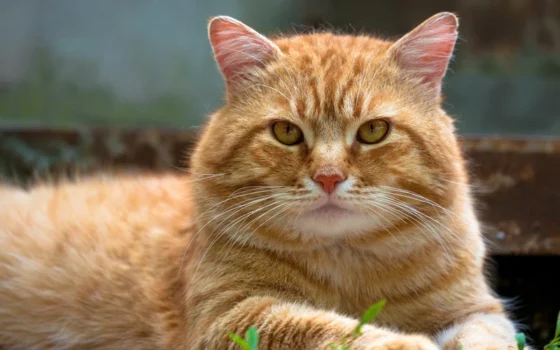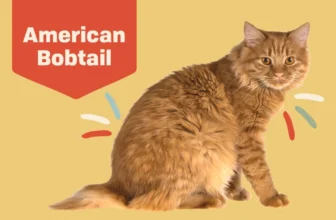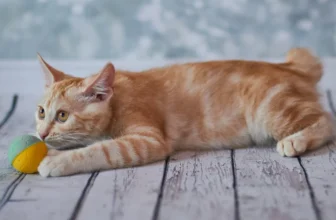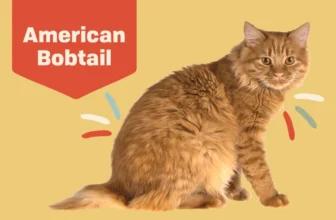As a proud owner of an American Bobtail cat, you must be aware of the beauty and uniqueness of their coat. However, with great beauty comes great responsibility. Caring for your American Bobtail’s coat is essential not just for maintaining its aesthetic appeal but also for ensuring their overall health and well-being. The right food, grooming, and supplements can make a huge difference in the quality of their coat. But how do you care for your furry friend’s fur? This guide will take you through every step of the process, from understanding your cat’s coat to managing common problems and keeping their coat healthy and lustrous. So, let’s dive in!
Understanding Your American Bobtail Coat
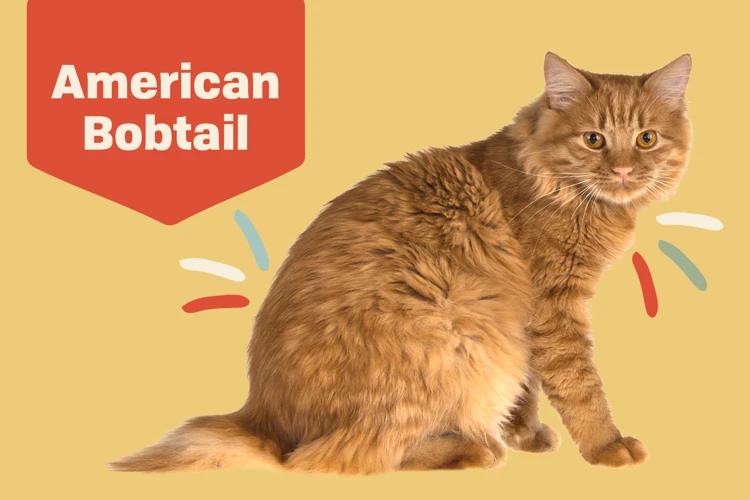
The coat of an American Bobtail cat is one of its defining features, and taking care of it is essential to keep your furry friend healthy and happy. It’s important to understand the different characteristics of your American Bobtail’s coat to better care for it. The density and texture of the coat can affect the grooming routine, while the colors and patterns can reflect the cat’s personality. To learn more about the various attributes of an American Bobtail’s coat, you can check out the different coat colors and patterns or read about the genetics behind them.
Density and Texture
The American Bobtail comes in different coat densities and textures, which require different levels of care. Dense coats are common among American Bobtails as they have evolved to withstand the harsh climates of the American West. This coat type has an undercoat and an overcoat, which aids in insulation to keep the cat warm. It’s essential to ensure that your cat’s dense coat is free from knots and mats, which can trap moisture and attract parasites. However, short-haired American Bobtails with less dense coats are less prone to matting but will still require regular grooming.
Texture also plays a part in the cat’s coat care routine. Silky, smooth coats are common among American Bobtails, especially short-haired ones. These coats tend to be easy to groom, requiring minimal brushing or combing to maintain their shiny appearance. Wiry or rough coats, on the other hand, can be challenging to maintain as they tend to knot and mat more easily, requiring more regular cleaning and brushing.
Regardless of the coat density or texture of your American Bobtail, proper grooming and hygiene are essential to maintaining a healthy coat. Regular grooming sessions and keeping an eye out for any skin irritations or parasites will help prevent any unwanted problems. For more information on the American Bobtail’s coat patterns, check out our article on spotting American Bobtail coats.
Colors and Patterns
American Bobtail cats have a unique coat that can come in a variety of colors and patterns. Here are some of the most common ones:
- Brown Tabby: This is the most common color variation for American Bobtail cats. Brown tabbies have a dense coat with bold, dark stripes.
- White: White American Bobtails have pure white fur and bright, expressive eyes. They can have blue or green eyes, and some may have odd-eyes, which means each eye is a different color.
- Black: Black American Bobtails have a sleek, shiny coat that is completely black. Their eyes are typically gold or copper in color.
- Red: Red American Bobtails have a warm, orange-colored coat. Their eyes are usually copper or gold.
- Cream: Cream-colored American Bobtails have a soft, almost pastel-colored coat. Their eyes can be blue or gold.
In addition to these solid colors, American Bobtails can also have a variety of patterns. Some of the most common patterns include:
- Classic Tabby: This pattern features bold, swirling patterns on the cat’s sides and a distinctive “M” shape on its forehead.
- Spotted Tabby: This pattern features scattered spots on the cat’s coat, rather than bold stripes.
- Mackerel Tabby: This pattern features thin, vertical stripes on the cat’s coat.
- Patched Tabby: This pattern features a combination of different colors and patterns on the cat’s coat.
- Bicolor: Bicolor American Bobtails have a coat that is primarily white with patches of another color, such as black, brown, or orange.
No matter what color or pattern your American Bobtail has, it’s important to care for their coat properly to keep it healthy and shiny.
Caring for Your American Bobtail Coat
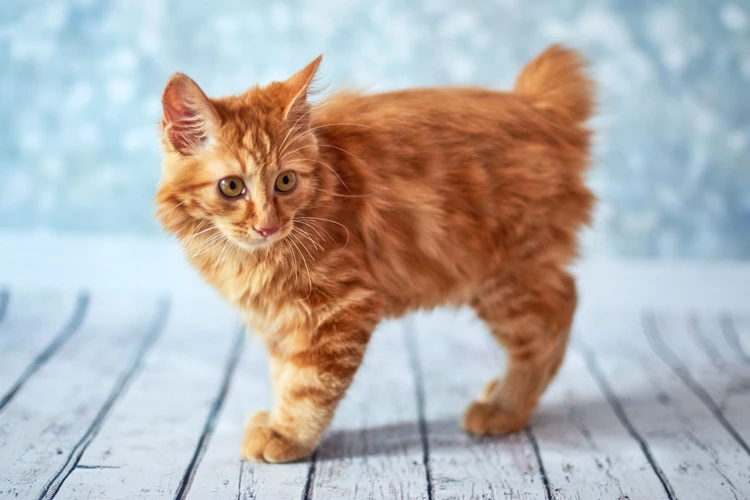
Keeping your American Bobtail’s coat healthy and shiny requires proper care and attention. No matter the length, texture, or pattern of their coat, regular grooming and bathing are essential for their overall well-being. Neglecting your cat’s coat can lead to matting, tangling, and an array of other coat problems. Understanding how to properly care for your American Bobtail’s coat will help keep them comfortable and happy. Let’s explore some helpful tips and tricks for maintaining their coat’s health and beauty.
Bathing
When it comes to bathing your American Bobtail, less is more. These cats are independent groomers and shouldn’t require frequent baths. In fact, over-bathing can strip their coat of its natural oils, leading to dryness, irritation, and dandruff. However, there are certain situations that call for a bath.
Some situations that may require a bath include:
- When the cat gets into something sticky or smelly
- If the coat is excessively dirty or greasy
- If your veterinarian recommends a medicated bath for a skin condition
When giving your American Bobtail a bath, be sure to use a cat-specific shampoo that won’t irritate their delicate skin. Before getting started, brush out any knots or tangles in their coat, as wet hair is more prone to tangling. Fill a sink or bathtub with a few inches of lukewarm water and slowly lower your cat into the water. Use a cup or sprayer to wet their coat, being careful to avoid their face and ears.
Here are a few additional tips to keep in mind:
- Work the shampoo gently into their coat, using a massaging motion
- Rinse thoroughly with lukewarm water
- Wrap your cat in a towel and gently pat them dry, being careful not to rub their hair too vigorously
- Consider placing a non-slip mat in the sink or tub to help your cat feel more secure
- Using a warm blow dryer on a low setting can help speed up the drying process, but be sure to hold the dryer at a safe distance from your cat’s skin and use a low heat setting to avoid burning them.
By following these bathing tips and only bathing when necessary, you can keep your American Bobtail’s coat looking and feeling its best.
To read more about specific coat types in Bobtail cats, check out our article on Tabby Bobtail cats. For more information on caring for your American Bobtail’s coat, head over to our section on American Bobtail coat care.
Grooming
Keeping your American Bobtail’s coat in top condition requires regular grooming. This involves a variety of tasks to keep their coat clean and free from mats and tangles. Here are some essential grooming tasks to keep in mind:
- Brushing: You should brush your American Bobtail’s coat regularly to remove loose hair and prevent mats from forming. Use a soft-bristled brush or a comb to gently work through your cat’s fur, starting at the head and working your way down to the tail. Avoid pulling or tugging on any tangles you encounter, as this can be uncomfortable for your cat.
- Bathing: While American Bobtails are relatively low-maintenance when it comes to bathing, a good bath every now and then can help keep their coat looking shiny and healthy. Use a mild, cat-specific shampoo and warm water to gently clean your cat’s coat. Be sure to rinse thoroughly to avoid leaving behind any soap residue.
- Trimming nails and hair: Keeping your American Bobtail’s nails trimmed will not only protect your furniture and carpets from scratches, but also prevent your cat’s nails from getting caught in their fur and causing discomfort. You may also want to trim any excess hair around their paws, ears, and other areas prone to matting.
- Checking for Ticks and Fleas: Fleas and ticks can pose a serious health risk to your American Bobtail, so it’s important to check them regularly for any signs of these parasites. Look for small black or brown specks (flea dirt) and tiny bumps or red spots on your cat’s skin. If you find any signs of fleas or ticks, talk to your veterinarian about the best way to eliminate them.
By incorporating regular grooming into your American Bobtail’s care routine, you can help keep their coat looking healthy and shiny, while also ensuring their overall health and well-being.
Brushing
Brushing your American Bobtail cat’s coat is an essential part of their grooming routine, and it helps keep their fur healthy and shiny. Here are some tips for effective brushing:
- Choose the right brush: There are various types of brushes available, and choosing the correct one depends on your cat’s coat type and length. For American Bobtails, a slicker brush works best as it helps remove dead hair and prevents matting.
- Start slowly: If your cat isn’t used to brushing, take it slow and steady. Introduce the brush gently and let your cat sniff and explore it first.
- Brush in the right direction: Start brushing from the head and work your way to the tail, following the direction of the fur growth. Brushing against the growth can cause discomfort and pain.
- Be gentle: Avoid pulling or tugging on your cat’s fur, as this can be painful and cause skin irritation. Use light, gentle strokes when brushing.
- Pay attention to sensitive areas: Your cat may have certain areas that are more sensitive than others. Pay attention to these areas and use a lighter touch when brushing them, such as the belly or armpits.
- Brush regularly: Regular brushing keeps your cat’s coat healthy and prevents matting. Aim to brush your American Bobtail at least once a week or more often during shedding season.
Remember to reward your cat with treats and praise during and after brushing sessions to make it an enjoyable experience for them. With proper brushing, your American Bobtail’s coat will be shiny, healthy, and free of mats and tangles.
Trimming nails and hair
It is important to not only take care of your American Bobtail’s coat but also its nails and hair. Trimming your cat’s nails and hair is an important aspect of cat grooming. Here are some tips to make it easier for both you and your cat.
Trimming the Nails: When trimming your cat’s nails, start by restraining your cat. You can use a cat scratcher or a towel to keep your pet from moving around too much. The best time to trim their nails is when they are relaxed, so try to do so after playtime when they are already a bit tired.
Use a pair of pet nail clippers to trim the tips of their nails. Be careful not to trim the quick, a pink area that contains blood vessels and nerves. Cutting it can cause bleeding and pain for your cat. If you accidentally cut the quick, apply some styptic powder to the nail to stop the bleeding.
| Tools Needed: | Steps: |
|---|---|
| Pet nail clippers | Hold your cat gently and steady its paw. |
| Styptic powder | Clip the tip of the nail leaving the quick untouched. |
| Towel or cat scratcher | Repeat the process for all nails. |
Trimming the Hair: Trimming your cat’s hair is important, especially if they have a long coat that tends to tangle and mat. Start by providing your cat with plenty of treats to keep them happy and occupied. Start from the neck and work your way down to the tail.
Pay special attention to the areas behind the ears, on the neck, and under the armpits. These areas are prone to matting and can cause discomfort to your cat. Use a pair of scissors or clippers that are specifically designed for pet grooming. Be careful not to accidentally nick your cat’s skin.
| Tools Needed: | Steps: |
|---|---|
| Scissors or clippers for pet grooming | Provide your cat with treats to keep them occupied. |
| Bath or groom your cat before trimming their hair | Start from the neck and work your way down to the tail. |
| Pay special attention to areas prone to matting |
Trimming your American Bobtail’s nails and hair is essential to keep them comfortable and healthy. Remember to always use the appropriate tools and be gentle yet firm when restraining your pet.
Checking for Ticks and Fleas
Ticks and fleas are common parasites that can cause serious health problems for your American Bobtail cat. Checking for ticks and fleas regularly can help prevent infestation and keep your pet healthy. Here are some steps to follow when checking for ticks and fleas:
| Step 1: | Check your cat’s coat regularly for ticks and fleas, especially during warm weather months when these parasites are most active. |
| Step 2: | Start at your cat’s head and use a fine-toothed flea comb to comb through the fur. Pay special attention to areas around the ears, eyes, and mouth, as well as the base of the tail and under the legs. |
| Step 3: | Look for small, dark specks that resemble dirt. These could be flea droppings or actual fleas themselves. You may also see small, reddish-brown insects moving through the fur – these are likely fleas. |
| Step 4: | Feel for small bumps or raised areas on the skin that may indicate the presence of a tick. Ticks can vary in size and color, from tiny and pale to larger and dark brown or black. They often attach themselves to areas with less hair, such as the belly or between the toes. |
| Step 5: | If you find a tick or flea on your cat, it’s important to remove it as soon as possible to prevent the spread of diseases. Use a pair of tweezers to grasp the tick as close to your cat’s skin as possible and pull gently until it releases its grip. For fleas, use a flea comb or special flea-removal shampoo to get rid of them. |
Remember to be gentle when checking for ticks and fleas, and reward your cat for their patience with some extra playtime or a favorite treat. Regular checks and preventative measures can go a long way in keeping your American Bobtail cat healthy and happy.
Food and Nutrition for a Shiny Coat
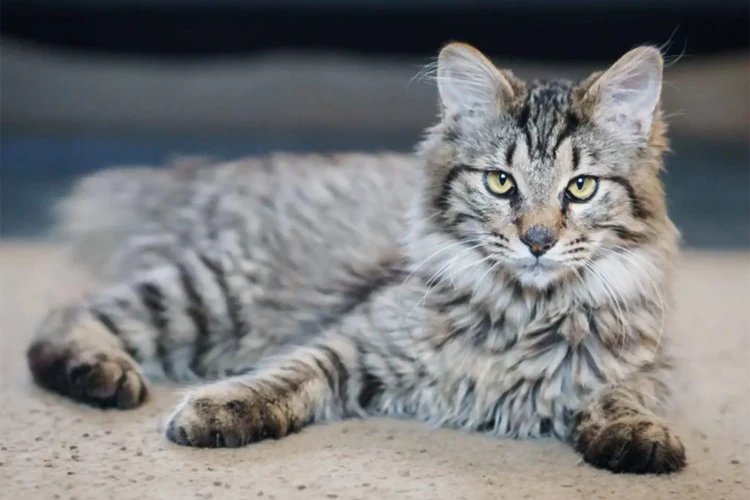
Our American Bobtail cats’ health and wellbeing are directly linked to their diet. This is especially true when it comes to their coat health. What your cat eats and drinks can greatly impact the quality and shine of their fur. In this section, we will explore the importance of nutritious food for a shiny coat and recommended diet to keep your American Bobtail’s coat healthy and beautiful.
Importance of nutrition
A healthy diet is crucial for maintaining the shiny coat of your American Bobtail cat. Proper nutrition provides the necessary vitamins and minerals that not only support a lustrous coat but also overall health.
Some important aspects of nutrition for your American Bobtail cat include:
| Protein | Fatty acids | Water |
|---|---|---|
| Protein is an essential nutrient for maintaining a healthy coat. It provides the building blocks for strong and healthy hair. Ensure that your cat’s diet includes high-quality protein sources such as chicken, turkey, and fish. | Fatty acids, such as Omega-3 and Omega-6, are essential for maintaining your cat’s coat health. They help to reduce inflammation, minimize shedding, and promote a shiny coat. Fish oil supplements are an excellent source of these essential fatty acids. | Water is essential for your cat’s health and hydration. It keeps your cat’s coat and skin moist and supple. Ensure that your cat has access to clean and fresh water at all times. |
Additionally, a diet rich in vitamins and minerals, such as Vitamins A, E, and B-complex, as well as zinc and biotin, helps to maintain a healthy coat. A balanced diet consisting of high-quality sources of protein, fiber, and fats can ensure your American Bobtail cat receives all the necessary nutrients for overall health and a shiny coat.
It is advisable to consult your veterinarian before making any changes to your cat’s diet. They can provide expert advice on the necessary nutrients and the amount of food to feed your cat based on their age, activity level, and health condition.
Remember, the nutrition you provide to your American Bobtail cat plays a critical role in maintaining a healthy and shiny coat, so make sure to provide a balanced and nutritious diet to your furry friend.
Recommended diet
A recommended diet for your American Bobtail cat is one that is rich in protein and healthy fats to help maintain a shiny coat. The diet should also be high in moisture to keep your cat hydrated and prevent dry skin.
Include a variety of proteins in your cat’s diet, such as chicken, fish, and beef. These proteins contain essential amino acids that are necessary for a healthy coat. It is also important to avoid low-quality fillers or artificial ingredients in your cat’s food.
Here are some specific foods to consider including in your American Bobtail’s diet:
- Salmon: This fish is rich in Omega-3 fatty acids, which help promote a healthy coat and skin.
- Chicken: Chicken is a great source of protein, but make sure it is boneless and skinless to prevent digestive issues for your cat.
- Turkey: Another great source of protein, turkey is also a lean meat that can help with weight management in your cat.
- Blueberries: These berries are high in antioxidants, which help reduce inflammation and promote a healthy coat.
- Sweet Potatoes: Sweet potatoes are a healthy source of carbohydrates for your cat, which help provide energy and fiber.
It’s essential to provide fresh, clean water for your American Bobtail cat at all times. This helps keep them hydrated and promotes healthy skin and coat.
A healthy and balanced diet is crucial for the health and appearance of your American Bobtail’s coat. Consult with your veterinarian for specific recommendations based on your cat’s age, weight, and health needs.
Supplements to Support Coat Health
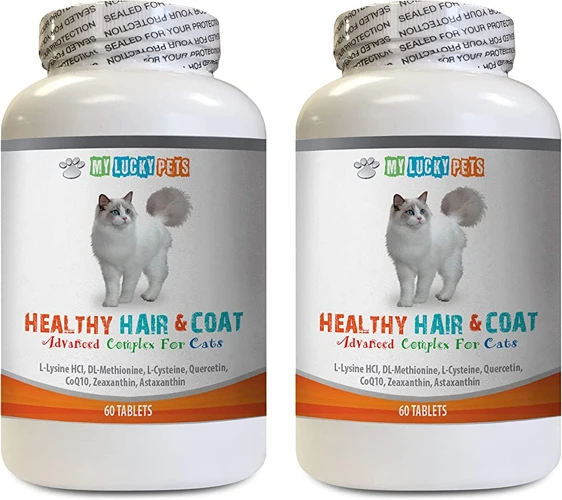
As much as proper grooming and nutrition are essential for your American Bobtail’s coat health, sometimes additional support is needed. This is where supplements come in handy. By providing your feline companion with essential vitamins and minerals, you can further enhance the coat’s shine, strength, and overall health. However, with so many supplements available on the market, it can be perplexing to choose the right one for your furry friend. In this section, we’ll explore the benefits of supplements and highlight some types to consider for optimal coat health.
Benefits of supplements
Supplements can be a great addition to your American Bobtail’s diet to support their coat health. Here are some benefits of supplements:
| Benefit | Description |
|---|---|
| Glossy coat | Supplements containing omega-3 and omega-6 fatty acids can promote a shiny, healthy coat. |
| Reduced shedding | Supplements with biotin and zinc can help reduce excessive shedding. |
| Less dandruff | Supplements with vitamin E can prevent skin from becoming dry and developing dandruff. |
| Stronger hair follicles | Supplements with amino acids can support the formation of strong hair follicles and prevent hair breakage. |
| Faster hair growth | Supplements with omega-3 and omega-6 fatty acids can nourish hair follicles and promote faster hair growth. |
It’s important to note that supplements should not replace a balanced diet, but rather be used as a complement to it. Always consult with your veterinarian before adding any supplements to your cat’s diet, as some may interact with other medications or have potential side effects.
Types of supplements to consider
The type of supplements you choose for your American Bobtail cat can make a big difference in the overall health and appearance of their coat. Here are some types of supplements you might consider adding to your cat’s diet:
| Supplement Type | Description |
|---|---|
| Omega-3 Fatty Acids | These supplements can help reduce inflammation and promote healthy skin and a shiny coat. Look for supplements made from fish oil, which is rich in omega-3s. |
| Vitamin E | Vitamin E is a powerful antioxidant that can help protect the skin and coat from damage. It can also help reduce dryness and itching. |
| Biotin | Biotin is a type of B-vitamin that can help strengthen the fur and prevent breakage. It can also help reduce shedding and make the coat appear fuller and healthier. |
| Probiotics | Probiotics can help support the digestive system, which can lead to healthier skin and coat. They promote the growth of “good” bacteria in the gut, which can help prevent infections and other issues. |
| Zinc | Zinc is a mineral that is essential for skin health. It can help reduce inflammation and improve wound healing, which can be especially important if your cat has a skin condition. |
Keep in mind that not all supplements are created equal, and it’s always a good idea to talk to your veterinarian before adding any new supplements to your cat’s diet. Your vet can help you determine what types of supplements are best for your cat based on their individual needs and health history.
Cat Hairballs: Prevention and Treatment

As a cat owner, it’s no secret that hairballs can be a nuisance for your feline friend. Not only can they cause discomfort, but they can also be a pain for you to clean up. However, before you panic and rush off to the vet, it’s important to understand that hairballs are a natural part of a cat’s grooming routine. In this section, we will discuss the causes of hairballs and provide you with tips on how to prevent and treat them to keep your American Bobtail healthy and happy. So, let’s dive in and learn more about this common issue that plagues our beloved feline friends.
Causes of Hairballs
Hairballs are a common issue in cats, and understanding the causes behind them is crucial for their prevention.
Causes of Hairballs
| Cause | Description |
|---|---|
| Frequent Grooming | Cats are known for their grooming habits, and as they lick their fur, loose hairs become trapped in their stomach, leading to hairball formation. |
| Long Fur | Cats with long hair are more susceptible to hairballs due to the increased amount of shedding and the difficulty in passing hairs through their digestive system. |
| Poor Diet | A diet lacking in nutrients or the wrong type of food can lead to indigestion and constipation, which may worsen hairball symptoms. |
| Dehydration | A lack of water can lead to dry and hard stools, making it harder for hairballs to pass through the digestive system. |
| Underlying Medical Issues | Medical conditions such as gastrointestinal disorders, diabetes, and hyperthyroidism can increase a cat’s likelihood of experiencing hairballs. |
While hairballs may seem like a minor inconvenience for cats, they can lead to serious health issues if left untreated. It is important to identify the root causes and take preventative measures to ensure your furry friend stays healthy and happy.
Preventing Hairballs
Hairballs are a common issue for American Bobtail cats, and they can be both uncomfortable and unsightly. Fortunately, there are steps you can take to prevent them. Here are some preventive measures you can take to reduce the likelihood of hairballs in your American Bobtail.
Description
Regular grooming
Grooming your American Bobtail regularly can help to remove loose fur before it gets ingested, reducing the amount of hair in their digestive system.
Dietary changes
Changing your American Bobtail’s diet to include more fiber can help to keep their digestive system moving, reducing the likelihood of fur getting trapped.
Increased hydration
Ensuring your American Bobtail is properly hydrated can help to keep their digestive system lubricated and moving efficiently, reducing the risk of hairballs.
Regular brushing
Regular brushing can help to remove loose fur and prevent it from being ingested, reducing the amount of hair in the digestive system.
By taking these preventive measures, you can significantly reduce the likelihood of hairballs in your American Bobtail, ensuring that they are comfortable and healthy. If your cat does develop hairballs despite your efforts, there are treatment options available. Be sure to consult with your veterinarian if you notice any symptoms of hairball issues in your American Bobtail.
Treating Hairballs
Hairballs can be a discomforting problem for American Bobtail cats. If your cat is experiencing hairball issues, there are several steps you can take to alleviate symptoms and prevent them in the future.
1. Give your cat hairball remedy: There are several over-the-counter hairball remedies available in pet stores that are specially formulated to help cats pass hairballs. These remedies often contain lubricants or enzymes that aid in the digestion process and allow for easier passage of hairballs. Be sure to follow the dosage instructions carefully.
2. Increase fiber intake: Increasing your cat’s fiber intake can help move hairballs through the digestive system. Consider adding canned pumpkin or a small amount of a high-fiber cat food to your cat’s diet. Just be sure to introduce any new food slowly to avoid digestive upset.
3. Regular grooming: Regular grooming removes loose hair before it can be ingested, reducing the chances of hairballs forming. It’s important to brush your cat’s coat regularly, especially during shedding seasons. This will remove any tangles or mats that can trap loose hair.
4. Encourage adequate hydration: One of the reasons hairballs can be so problematic is because they can become dry and difficult to pass. Encourage your cat to drink plenty of water throughout the day. You can also add wet food to their diet to increase hydration.
5. Visit your veterinarian: If your cat is experiencing frequent hairballs or is showing signs of distress, such as vomiting, lethargy or loss of appetite, it’s important to visit your veterinarian. They can evaluate your cat’s overall health and provide additional recommendations for treating hairballs or preventing them in the future.
By taking these steps to treat and prevent hairballs, you can help your American Bobtail cat maintain a healthy and comfortable coat.
Common Coat Problems and Solutions

As much as we adore our American Bobtail cats, taking care of their fur can be challenging. Sometimes, despite our best efforts, our cat’s coat may develop problems that require immediate attention. But don’t worry, as a dedicated cat owner, there are ways to tackle these common coat problems head-on. In this section, we will explore some of the most frequently encountered coat issues and provide simple and practical solutions to get your feline friend’s coat back to its lustrous shine. So, let’s dive right into it!
Matted hair and knots
Matted hair and knots can be a common problem for American Bobtail cats. This is especially true for those cats with longer or thicker coats.
Causes: The primary causes of matted hair and knots in American Bobtail cats are lack of grooming, lack of brushing, and excessive shedding. Cats who spend a lot of time outdoors may be more prone to tangles in their fur, as they are more likely to come into contact with dirt and debris.
Symptoms: A matted coat can be uncomfortable for a cat, and may cause skin irritation and even infection if left untreated. You may notice your American Bobtail avoiding being petted or groomed, or even showing signs of discomfort or pain when touched in certain areas.
Prevention: Prevention is key when it comes to matted hair and knots. Brushing your cat regularly, especially if they have a long or thick coat, can help to prevent tangles from forming. You may also want to consider a high-quality, detangling shampoo and conditioner to help keep your American Bobtail’s coat smooth and silky. If you notice any knots or tangles in their coat, it is important to address them promptly to prevent further matting from occurring.
Treatment: If your American Bobtail does develop matted hair or knots, it is important to address them as soon as possible. Attempting to brush out severe tangles can be painful for your cat, so it is important to be gentle and patient. You may want to consider using a specialized matting comb or even seeking professional grooming services to help your cat’s coat regain its softness and sheen. In severe cases, shaving the affected areas may be necessary to prevent further pain or discomfort for your American Bobtail.
Conclusion: With proper care and attention, matted hair and knots can be prevented in your American Bobtail cat. Regular grooming and brushing, along with high-quality pet products, can help keep their coat healthy and beautiful. If you do notice any signs of matting or knots, it is important to address them as soon as possible to prevent further problems.
Excessive shedding
Excessive shedding in American Bobtail cats can be distressing for both the cat and their owner. Shedding becomes a problem during the shedding season, usually during the summer and winter months. However, it can also occur due to hormonal imbalances, poor diet, lack of exercise or underlying health problems.
Understanding the Shedding Cycle:
Cats shed naturally as their coat renews itself. However, excessive shedding occurs when the process goes on for too long. Shedding usually occurs during a period of three weeks or less. During that time, the cat should ideally be bathed and groomed regularly to remove any loose hairs, which helps prevent hairballs.
Tips to Control Excessive Shedding:
| Tip | Description |
|---|---|
| 1 | Feed your cat with high-quality food that is rich in Omega-3 and Omega-6 fatty acids. These nutrients help promote a healthy coat and skin. |
| 2 | Provide your cat with enough water to stay hydrated. Dehydration can lead to dry and itchy skin, which can lead to excessive shedding. |
| 3 | Regular grooming sessions help to remove any loose hairs before they fall. This reduces the number of hairs in your cat’s environment, the risk of hairballs, and overall shedding. |
| 4 | Invest in a good vacuum cleaner, lint roller or pet hair remover brush to keep your home clean and clear of cat hairs. |
| 5 | If excessive shedding persists, consult with your vet to rule out any underlying health issues that may cause excessive shedding. |
Conclusion:
Controlling excessive shedding in American Bobtail cats is vital to maintaining a healthy and well-groomed coat. A combination of proper nutrition, hydration, regular grooming, and veterinary check-ups can help prevent shedding and promote a healthy coat. By implementing these tips and understanding the shedding cycle, you can help your cat feel more comfortable and your home cleaner.
Skin irritation and itching
Skin irritation and itching are common problems that affect many American Bobtail cats. If your cat is constantly scratching or licking itself, you may notice redness, inflammation, and scabs on its skin. Some possible causes of skin irritation include allergies, parasites, bacterial or fungal infections, or even stress. Here are some steps you can take to help your cat overcome skin irritation and itching:
| Step 1: | Visit your veterinarian to determine the underlying cause of skin irritation. |
| Step 2: | Follow your veterinarian’s recommended treatment plan. Depending on the cause of skin irritation, treatment may include antibiotics, antifungal medication, or medicated shampoos or ointments. |
| Step 3: | Keep your cat’s living area clean and well-maintained. Vacuum regularly and wash your cat’s bedding and toys to remove any potential allergens or irritants. |
| Step 4: | Consider using a hypoallergenic cat litter, as some cats may be sensitive to certain types of litter. |
| Step 5: | Incorporate omega-3 fatty acids into your cat’s diet to help reduce inflammation and promote healthy skin. Fish oil supplements or foods that contain sources of omega-3 fatty acids, such as salmon or sardines, can be beneficial. |
| Step 6: | Avoid over-bathing your cat, as this can dry out their skin and exacerbate irritation. Instead, limit baths to every few months or as recommended by your veterinarian. |
Remember to always consult your veterinarian before administering any treatments or supplements to your American Bobtail. By taking proactive steps to address skin irritation and itching, you can help your cat maintain a healthy and comfortable coat.
Dry skin
Dry skin is a common issue faced by American Bobtail cats that can lead to discomfort and irritation. If left unaddressed, dry skin can also cause other problems, such as excessive shedding and matted fur. If you notice your cat scratching more than usual or see flakes on their skin, it’s likely that they are suffering from dry skin. Here are some ways you can prevent and treat dry skin in your American Bobtail:
- Hydration: Ensure that your cat is drinking enough water to keep their skin hydrated. A lack of hydration can lead to dryness and flakiness.
- Diet: Feeding your cat a balanced and nutritious diet can also help keep their skin healthy. Include foods that are high in omega-3 fatty acids, such as salmon, to promote skin health.
- Bathing: While over-bathing can strip oils from your cat’s skin, occasional baths with a moisturizing shampoo can help alleviate dry skin. Be sure to rinse thoroughly and dry your cat thoroughly with a towel or low heat blow dryer.
- Humidity: Use a humidifier in your home to increase the moisture in the air, which can prevent dry skin. This is especially important during the winter months when heaters can dry out the air.
- Supplements: Certain supplements, such as omega-3 fatty acid supplements or vitamin E supplements, may be helpful in promoting skin health in cats. Consult with your veterinarian before adding any supplements to your cat’s diet.
By following these tips, you can help prevent and treat dry skin in your American Bobtail cat and promote a healthy and shiny coat. Remember to always consult with your veterinarian if you notice any persistent or concerning issues with your cat’s skin or coat.
Other Tips for Your American Bobtail’s Coat Health
Maintaining the health of your American Bobtail’s coat is important for their overall wellbeing. In addition to regular grooming and a balanced diet, there are other tips you can follow to ensure your cat’s coat is always shiny and healthy. From scheduling regular checkups to ensuring your cat is properly hydrated, every bit of care helps. In this section, we will explore additional tips and tricks to keep your American Bobtail’s coat in top condition. Read on to learn how you can improve your cat’s coat health and help them lead a happy and healthy life.
Regular Checkups
Regular checkups are crucial to maintaining your American Bobtail cat’s overall health and ensuring their coat stays in top shape. Schedule visits with your veterinarian at least once a year, or more frequently if your cat has any ongoing health issues.
During checkups, your vet will examine your cat’s coat and skin for any signs of problems, such as rashes or skin infections. They may also recommend a specific grooming routine or prescribe medication if necessary.
Make sure to discuss any concerns or questions you have about your American Bobtail’s coat with your veterinarian. They can provide you with valuable information and advice regarding your cat’s unique needs, which can vary depending on various factors such as breed, age, and overall health.
In addition to routine checkups with your vet, it’s important to regularly inspect your cat’s coat at home. Look for any abnormalities or changes in your cat’s coat, such as bald spots or excessive shedding, and bring them to your veterinarian’s attention immediately.
By staying on top of your cat’s health and coat care, you can proactively prevent any potential issues and keep your American Bobtail looking and feeling their best. Don’t forget to keep up with any recommended vaccinations and flea/tick prevention treatments as well to ensure your cat stays healthy and happy for years to come.
Listed below are some key takeaways for regular cat checkups:
- Schedule annual visits with your veterinarian, or more frequently if needed.
- During checkups, the vet will examine your cat’s coat and skin for any issues.
- Discuss any concerns or questions you have with your vet regarding your cat’s coat care.
- Regularly inspect your cat’s coat at home for abnormalities or changes.
- Stay up-to-date with recommended vaccinations and flea/tick prevention treatments.
Hydration
Hydration
Proper hydration is key to maintaining a healthy coat for your American Bobtail cat. Dehydration can lead to dry skin, dull coat, and even hair loss in severe cases. Always ensure your cat has access to fresh water and encourages them to drink regularly.
Wet Food
Feeding your American Bobtail wet food can also help with hydration. Wet food has a higher moisture content than dry food, making it an excellent way to ensure your cat stays hydrated.
Water Fountains
Some cats prefer running water to still water. Investing in a water fountain for your American Bobtail may encourage them to drink more water. The sound of running water can be more appealing to cats and may help them drink more regularly.
Check for Dehydration
When checking for dehydration, you can perform a quick skin test by grabbing a fold of skin and releasing it. If the skin snaps back into place quickly, your cat is hydrated. If the skin takes longer to return to its place, your cat may be dehydrated and may need extra water. Always consult with your veterinarian if you suspect your cat may be dehydrated.
Keeping your American Bobtail hydrated is essential for maintaining a healthy coat. Encourage them to drink regularly, try wet food or invest in a water fountain, and keep an eye out for any signs of dehydration. By following these simple tips, you can help ensure your cat has a shiny, healthy coat.
| Signs of dehydration in cats: | Loss of skin elasticity | Thick saliva | Lethargy |
|---|---|---|---|
| Dry nose and mouth | Panting | Sunken, dry-looking eyes | |
| Inadequate or no urination | Loss of appetite | High body temperature |
Conclusion
In conclusion, caring for the coat of your American Bobtail is an essential aspect of their overall health and well-being. It is not just about making them look good, but it also helps prevent various skin problems and parasites.
Regular grooming, brushing, and trimming are crucial in maintaining a healthy and shiny coat. Regular baths are also important, but it is essential to be cautious with the frequency and the products used.
A well-balanced diet plays a significant role in keeping your American Bobtail’s coat healthy. Always ensure they are getting the necessary nutrients to support their overall health, and consider incorporating supplements if necessary.
Preventing hairballs and addressing any coat problems that arise as soon as possible can save your cat from unnecessary discomfort and even expensive vet bills.
Remember to schedule regular check-ups with the vet and keep your American Bobtail hydrated. With these tips and constant attention, you can keep your cat’s coat looking great and keep them healthy and happy.
Frequently Asked Questions
1. How often should I bathe my American Bobtail?
American Bobtails generally do not require frequent bathing, as they have a natural ability to keep themselves clean. However, you can bathe them once every three months or as needed.
2. Is it necessary to trim my American Bobtail’s nails?
Yes, trimming your American Bobtail’s nails is important to prevent them from growing too long and breaking. You can trim their nails once a month.
3. How often should I groom my American Bobtail?
You can groom your American Bobtail every day or every other day. This helps keep their coat shiny and free from tangles and mats.
4. What kind of food should I feed my American Bobtail for a healthy coat?
You should feed your American Bobtail a high-quality, protein-rich diet with essential fatty acids. Wet food is also preferable to dry food, as it helps promote hydration.
5. Can supplements help improve my American Bobtail’s coat health?
Yes, certain supplements like omega-3 fatty acids and biotin can help improve your American Bobtail’s coat health. Consult with your vet before adding any supplements to their diet.
6. How can I prevent hairballs in my American Bobtail?
You can prevent hairballs in your American Bobtail by brushing their coat regularly to remove loose hair, feeding them a diet high in fiber and moisture, and giving them hairball-prevention treats or supplements.
7. What should I do if my American Bobtail has matted hair?
If your American Bobtail has matted hair, use a detangling spray and a wide-toothed comb to carefully comb out the mats. If the mats are too severe, consider taking them to a professional groomer to avoid causing pain or discomfort.
8. How can I help my American Bobtail with excessive shedding?
To help your American Bobtail with excessive shedding, brush them regularly to remove loose hair, feed them a high-quality diet, and consider using a shedding control shampoo when you bathe them.
9. How can I treat my American Bobtail’s dry skin?
You can treat your American Bobtail’s dry skin by adding healthy oils like salmon oil or coconut oil to their food, providing them with enough hydration, and using a moisturizing shampoo when you bathe them.
10. Can I use human shampoo on my American Bobtail?
No, you should never use human shampoo on your American Bobtail. Instead, use a mild, cat-specific shampoo to avoid irritation or allergic reactions.

